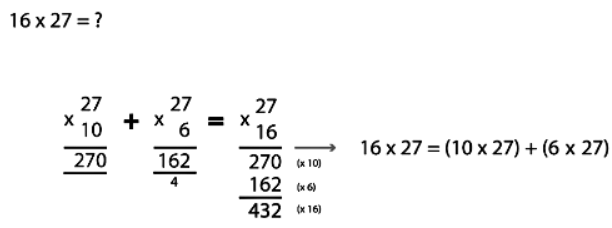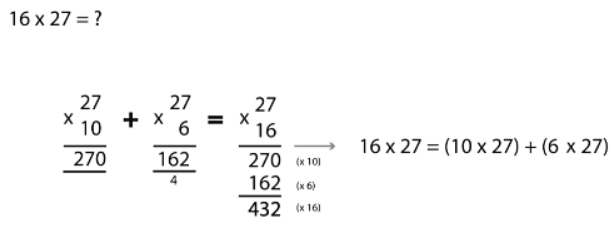Best Study Material for Year 6 Exam
Year 6 Exam > Year 6 Notes > Year 6 Mathematics > Multiplication up to 4-digits by 2-digits
Multiplication up to 4-digits by 2-digits | Year 6 Mathematics PDF Download
Long Multiplication
- Long multiplication involves breaking down a multiplication problem into smaller, more manageable parts.
- By simplifying the problem, we can solve each part individually and then combine the results to find the final answer.
Examples
Example 1: 263 x 18=
Sol: Let's break this calculation into two parts again and then add together our two answers. 263 x 18 = 4734
263 x 18 = 4734
Example 2: 16 x 27 =
Sol: We don’t know our 16 or 27 times tables off the top of our head, so what can we do?
16 = 10 + 6, so to multiply by 16 we could multiply by 10 and multiply by 6 and add the answers together.
If we do the calculation the other way around we get the same answer.
27 = 20 + 7, so to multiply by 27 we could multiply by 20 (x10 and then x2) and multiply by 7.
16 x 27 = 432
The document Multiplication up to 4-digits by 2-digits | Year 6 Mathematics is a part of the Year 6 Course Year 6 Mathematics.
All you need of Year 6 at this link: Year 6
|
54 videos|54 docs|17 tests
|
FAQs on Multiplication up to 4-digits by 2-digits - Year 6 Mathematics
| 1. What is the process for multiplying a 4-digit number by a 2-digit number? |  |
| 2. How can I ensure accuracy when multiplying numbers of this size? |  |
Ans. To ensure accuracy when multiplying large numbers, it is important to double-check your calculations and carry over correctly. You can also use a calculator to verify your answers.
| 3. Are there any shortcuts or tricks for multiplying large numbers like these? |  |
Ans. Some people find it helpful to break down the multiplication into smaller, more manageable steps. For example, you could multiply the 4-digit number by each digit of the 2-digit number separately and then add the results together.
| 4. What are some common mistakes to avoid when multiplying numbers of this size? |  |
Ans. Common mistakes when multiplying large numbers include misplacing digits, forgetting to carry over numbers correctly, and making errors in multiplication. It's important to double-check your work and take your time to avoid these errors.
| 5. How can I practice and improve my skills in multiplying large numbers? |  |
Ans. One way to practice and improve your skills in multiplying large numbers is to work on various practice problems and exercises. You can also use online resources or math apps to help reinforce your understanding of the multiplication process.
Related Searches
























